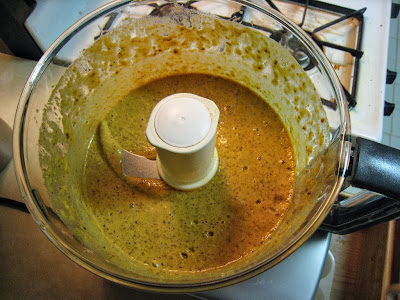It may not be German, and it's certainly not healthy, but this was one of the most delicious soups I've ever eaten. Made by a special friend, it was put together with precision, to ensure that everything came out perfectly. With ingredients like beer, cheddar cheese, cream, and bacon, I'm not sure how this dish could possibly be bad, but thankfully it delivered on flavor, where it lacked in nutritional value. Highly recommend this at an Oktoberfest party, or on a cold winter's night. And definitely look for smoked cheddar if you can find it - it makes a huge difference in the flavor.
Beer-and-Cheddar Soup
From Food & Wine, Contributed by Jonathon Erdeljac
- 1/3 pound piece of slab bacon, sliced 1/3 inch thick and cut into 1/3-inch dice
- 1 celery rib, finely chopped
- 1 small onion, finely chopped
- 1 large jalapeño, seeded and chopped
- 2 large garlic cloves, minced
- 1 tablespoon chopped thyme
- One 12-ounce bottle lager or pilsner
- 2 1/4 cups low-sodium chicken broth
- 4 tablespoons (1/2 stick) unsalted butter
- 1/4 cup all-purpose flour
- 1 cup heavy cream
- 1/2 pound sharp yellow cheddar cheese, coarsely shredded
- 4 ounces smoked cheddar cheese, coarsely shredded
- Salt and freshly ground pepper
- Garlic-rubbed toasts, for serving
In a large saucepan, cook the bacon over moderate heat until
the fat is rendered and the bacon is crisp, 7 minutes. Using a slotted spoon,
transfer the bacon to a bowl. Add the celery, onion, jalapeño, garlic and thyme
to the saucepan and cook over moderate heat, stirring, until softened, 8
minutes. Add half of the beer and cook until reduced by half, 5 minutes. Add 2
1/4 cups of chicken broth and bring to a simmer.
In a small skillet, melt the butter. Add the flour and cook
over moderate heat, stirring, until lightly browned, about 2 minutes. Whisk
this roux into the soup until incorporated and bring to a simmer. Cook until
thickened, about 8 minutes. Add the heavy cream, cheddar cheeses and the
remaining beer and simmer, stirring occasionally, until thick and creamy, about
5 minutes. Stir in the bacon and season with salt and pepper. Add a few
tablespoons of broth if the soup is too thick. Serve the soup with garlic
toasts.
The cheddar soup can be refrigerated overnight.
Rewarm gently and thin with additional broth.


























